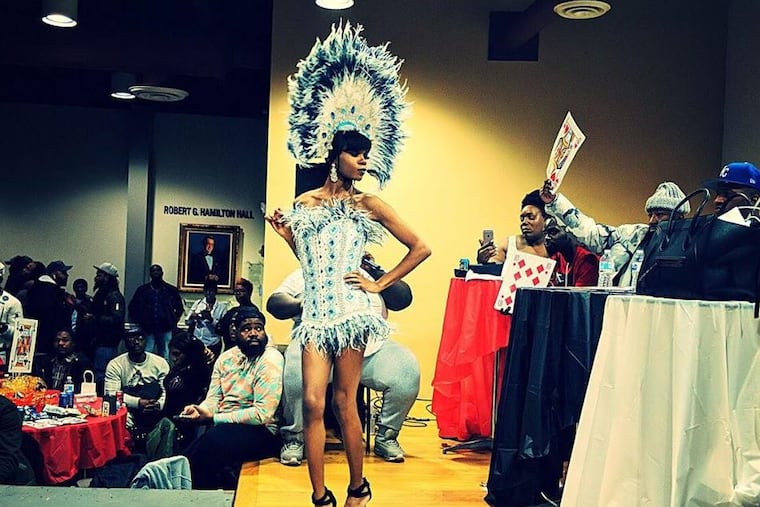Philadelphia’s ballroom scene makes a comeback with a monthly night at Woody’s
"There really wasn't a frequently occurring vogue night here in the city and there hasn't been for quite some time now."

Starting on Wednesday, Nov. 14, Gayborhood mainstay Woody's will host Philly Vogue Nights 2.0, a monthly series of vogue nights for the ballroom scene — a global community built by queer and trans people of color. As this subculture has been brought to the forefront via shows like Elegance Bratton's My House on Viceland and Ryan Murphy's Pose on FX, organizers of Philly's scene have begun to revive their own community, which dates to 1989.
"There really wasn't a frequently occurring vogue night here in the city, and there hasn't been for quite some time now," said Rich LaBoy, known to the ballroom community as Rich Miyake-Mugler. "There was a real need because there's been an empty hole for so long."
Vogue nights allow participants to gather and hone their skills on the ballroom floor in a low-impact setting while competing for small trophies and cash. Competitions include voguing; "realness," a type of identity performance; runway walk; fashion; and appearance.
Though balls were thrown as far back as the Harlem Renaissance, the house-ballroom scene began in New York City in the early 1970s. Kicking off with the House of LaBeija, the scene started in uptown Manhattan, becoming the home of the then-new dance style "voguing." And though that story is often told, Philadelphia's role in the growth and expansion of this long-running subculture is less known.
"We were actually the second ballroom city in the country," LaBoy said. Philadelphia's first ball was the Onyx Ball in August 1989, which will be celebrated in a 30th anniversary weekend featuring historic memorabilia next August.
Philadelphia is an integral part of the history of ballroom. Paris Dupree, an iconic voguer and reported originator of the "old way" — the original style of voguing that focuses on a more static series of poses mimicking things one might see in the pages of Vogue magazine — is originally from Philadelphia. It was her series of balls that gave Paris Is Burning, the 1991 documentary that was the world's first on-camera look into ballroom, its name. "Love is the Message," a song routinely played at balls since its release, is by MFSB, otherwise known as Philadelphia International Records' house band.
One of the pioneers of ballroom in Philadelphia is Alvernian Davis, known in the ballroom community as Alvernian Prestige, founder and reigning father of the Philly house of Prestige. "I'm quite sure that history will tell — other people in New York will say they had mini-balls before, probably in the 1980s — but history will tell that I was the first person to create a mini-ball series," he said about balls that have fewer categories and that are generally shorter than the main events.
Alvernian founded Elements of Vogue, a weekly vogue night originally hosted at the now-shuttered dance club Nile in 1991 that ended three years ago after various venue shifts. Though offshoots of ballroom, like the next-generation kiki scene (a subset of ballroom for younger participants), flourished, there was a dearth of regular events for ballroom competitors and attendees.
But Philadelphia remains active and a part of the now-international community in other ways. Davis hosts one of a few major balls in Philadelphia — the annual Dorian Corey Awards Ball, which will take place Feb. 2. Houses in the city like Prodigy (which began as the Philadelphia chapter of the House of Ebony) and Lanvin are well-known throughout the subculture. Ranika Camille, known to the community as Ranika Prodigy, is a Philly commentator who will receive the "Voice of a Generation" award in February at the Ballroom Throwbacks Awards Ball. "Her sound really comes from Philly," said Philadelphia DJ Deelish, who DJs various ballroom events.
Vogue Nights 2.0 is not only a frequent space to gather, commune, and compete, but for Woody's, it is also an effort to recontextualize its space and make inroads with a community that once might not have felt welcome. Ballroom as a community is a creation of people who were being excluded from other queer spaces. Philadelphia's Gayborhood has had high-profile issues with racism, and Woody's is actively trying to fight the perception that the club discriminates against people of color.
Of Philly Vogue Nights 2.0's various categories, one will include a cross promotion with the More Color, More Pride campaign: For team face, a competition in which pairs compete on skin clarity, symmetry, and bone structure, contestants are asked for one member to dress in all brown and one in all black and to use the More Color, More Pride flag as a prop to sell their faces.
"[Woody's] went through some really extensive training provided by the City of Philadelphia and really wanted to make sure that people of color would feel comfortable in their space," LaBoy said. "They came to me and my partners in this, wanting to do something to highlight how important it is that [the entire community] all feels included."
DANCE
Philly VOGUE Nights 2.0
9 p.m.-1 a.m. Wednesday, Nov. 14, Woody's, 202 S. 13th St., woodysbar.com